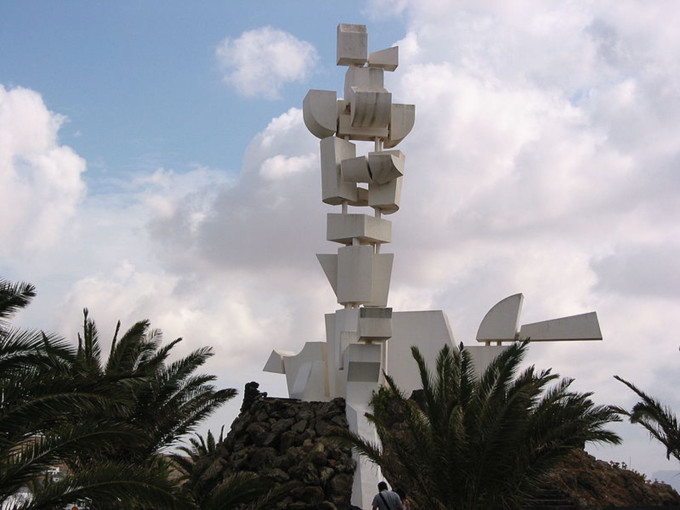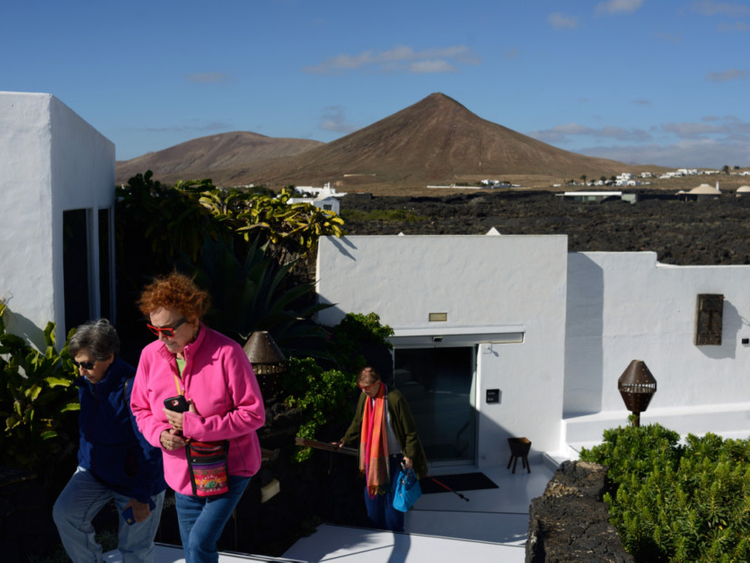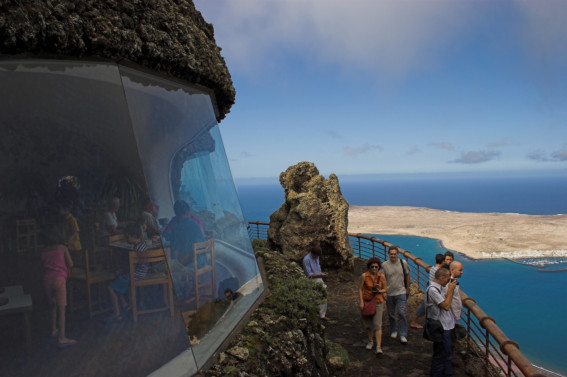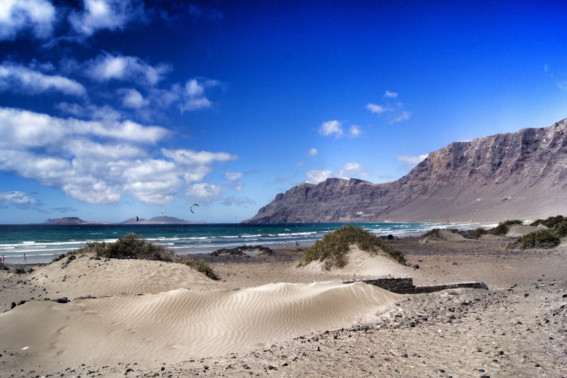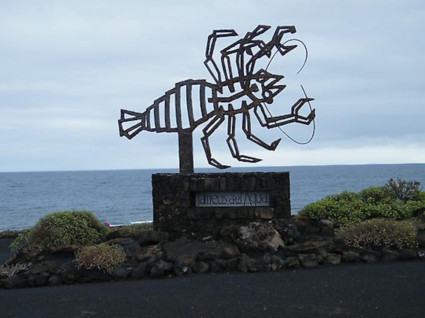
Low white villa clusters bask in the warming winter sun as dormant volcano cones rise towards the sky, their shadows slowly creeping into the villages. Vines grow low in the gravelly lava picon fields, sheltered from the prevailing wind by carefully-crafted stone walls. And frozen lava flows perpetually to reach to white-topped waves and the ocean beyond.
This is Lanzarote, one of the seven main islands that together make up Spain’s Canary Islands, sitting in the Atlantic about 125 kilometres off the coast of southern Morocco and two and a half hours’ flying time from Madrid.
The artistic ideals of Manrique still shape the island, its aesthetics and its environment.
But unlike other coastal areas and islands of Spain, Lanzarote has forcefully retained its traditional culture, architecture and feel, consciously rejecting the hotel and high-rise economy of mass tourism. Think Spain and the images of boozy bars, garish discos, fast food, happy hours and thousands of umbrellas covering bronzed and burnt bodies on beaches spring to mind. Benidorm, Malaga, the Costa Brava, Ibiza, the Balearics and the Costa del Sol represent the boom and bust of all-inclusive package holidays, fish ‘n’ chips Brits, and plane loads of holidaying-making mayhem let loose for a week at a time.
But mostly not in Lanzarote.
The entire island — it’s about 846 square kilometres in total, making it bigger than the emirate of Umm Al Quwain but smaller than Fujairah — is a Unesco biosphere reserve, where architecture is regulated even down to the colour of paint permitted on buildings, and new development is strictly controlled.
The island still lives by the Manrique dialectic of harmony in nature and cherishing the perpetual environmental conflict of a landscape violently shaped by the upheaval of the inner core of earth, the wind and the sea.
Yes, the commercial appeal of tourism by the thousands has not been ignored, it’s just been reined into three controlled clusters in Costa Teguise, Playa Blanca and Porta del Carmen, as Manrique envisaged. And the rest of the island that’s home to 150,000 year-round — and 500,000 more in the holiday seasons — is still an anachronism honouring the artist’s vision.
So, who was this man who, even 25 years after his death in a car accident, still holds sway on Lanzarote?
He was born a twin into a prosperous family in the island’s capital, Arrecife, in 1919. His father was a food merchant with small holdings across the island.
On the northern and north-western coasts, sheer cliffs rise dramatically from the Atlantic, with volcanic folds and the violent upheaval of unseen forces beneath adding a tense and permanently climatic gravity to the island’s geography.
It was here, in Famara, now a surfing and kite-surfers’ paradise, that Manrique’s father built a summer home in a small village, Caleta. Here, where the black lava folds hold pools of crystal clear water between tides, where strong and fast tides pull and shape greying sand into diamond-shaped patterns that catch the fifty shades of greys and browns from the overbearing cliffs, Manrique found the colours of his future palette. There was beauty in the violence that carved the island, fingers of lava that slid under the waves, like flows of congealed blood that poured forth from the death throes of some unearthly conflagration beneath the surface.
“My greatest happiness is to recall a happy childhood, five-month summer vacations in the Caleta and Famara Beach,” he later wrote. “Its eight kilometres of clean and fine sand framed by cliffs of more than four hundred metres’ high that reflected on the beach like a mirror. That image has been engraved on my soul as something of extraordinary beauty that I will never forget in all my life.”
And there was violence too for the young man, who volunteered and served as an artillery soldier on the mainland for Franco’s Nationalists during the bloody Spanish Civil War. He never spoke about those days, but once he returned to the island in the summer of 1939, he went to the roof of the family’s Arrecife home, took off his uniform, stomped on it, doused it in petrol and put a match to it.
He did spend two years studying technical architecture in Tenerife before entering the Academas des Belle Artas de San Fernando in Madrid on a scholarship in 1945, later graduating as an artist and professor.
By 1964, Manrique was living in New York, immersed in an artistic community shaped by the beginnings of modern art, beatniks, writers, bohemians and the Cuban community in the Lower East side. He was also enjoying considerable commercial success and critical acclaim as an artist, with multiple exhibitions in Span, Germany Sweden, Italy, Austria, Finland, Japan and at New York’s Guggenheim Museum in 1964.
He collaborated with Andy Warhol and partied with Bob Dylan, touched the individualism and liberalism of an early psychotic age, but always felt the pull of his native island even on Manhattan island.
“More than ever I feel true nostalgia for the real meaning of things, for the pureness of the people, for the bareness of my landscape, and for my friends,” he wrote then. “My last conclusion is that Manhattan in New York is like a rat trap. Man was not created for this artificiality. There is an imperative need to go back to the soil. Feel it. Smell it. That’s what I feel.”
But that exposure to modernity, its concrete towers, its commercialism and its relentless pursuit of individualism, had a profound effect and artistic epiphany on Manrique.
“When I returned from New York, I came with the intention of turning my native island into one of the most beautiful places in the planet, due to the endless possibilities that Lanzarote had to offer,” he later explained.
Today, the Haria still holds all the characteristics and feeling that Manrique experienced as he made the mountain village his home. Its narrow streets where front doors open directly onto whitewashed laneways, a village square shaded by Canary Island pines and palm trees, epitomises a timelessness that still endures. The village is known for the valley of a thousand palm trees, and local custom has it that a new one is planted every time a baby is born.
For the island, the lure of lucrative tourism development offered an opportunity to embrace economic growth as never before, but it was also a threat that would forever change the island’s landscape. For Manrique, whose ceaseless campaigning and deep knowledge of local traditions proved crucial, the threat of mass tourism needed to be curtailed and controlled. He proposed limiting it to the three areas while safeguarding the rest of the island’s heritage and architecture.
He campaigned for traditional buildings to be maintained and was instrumental in banning advertising billboards from the island’s landscape and highways, and pressed the local government to adopt strict planning protocols.
At the same time Manrique was advising and planning six main tourism attractions that fed the need for tourism — but controlled it on terms that were limited but accentuated the island’s natural features. He planned and designed a carefully built lookout, Mirador de Rio, built high into the north cliffs overlooking the bird sanctuary island of La Graciosa; another at Jameos del Aqua that included an auditorium built into volcanic caves. Today, these six attractions draw busloads of tourists, but in the carefully managed scenarios that Manrique meticulously planned.
He was fascinated too by mechanical movement and the power of the wind. As a boy growing up in Arrecife, Manrique was exposed to the low salt flats, where traditional windmills pumped salt water to different terraced layers. There, it evaporated, leaving salt deposits behind in what was the island’s traditional mainstay industrial activity for years.
He was fascinated too by the intensive labour that was required to make the arid island somewhat fertile, with backbreaking labour required to draw water and carefully manage it as it flowed to bring life to scant crops and vines.
In Taro de Tachiche, Manrique also planned and built a home. On the surface, it is a traditional home, yet beneath, interconnecting rooms are shaped in the natural voids of a lave floe, where you live almost as one in what were the gaseous burbs of blackened and crisped molten rock. Today it is home to the Cesar Manrique Foundation that is charged with ensuring the legacy of the artist endures and is relevant today, 25 years after his death in a car accident right outside the gates of this architectural amalgamation of nature and magma.
Mick O’Reilly is the Foreign Correspondent for Gulf News, based in Madrid.



